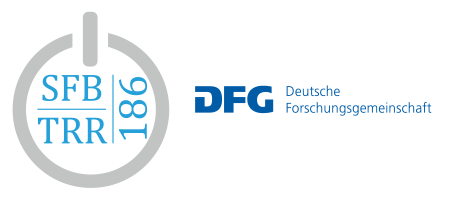
Prof. Dr. Frauke Melchior

Zentrum für Molekulare Biologie der Universität Heidelberg (ZMBH)
Im Neuenheimer Feld 282
69120 Heidelberg
Phone: +49 (6221) 54-6804
E-mail: f.melchior@zmbh.uni-heidelberg.de
Professor for Molecular Biology (W3)
2018 - FEBS / EMBO Woman in Science Award
2014 - Elected member of the Deutsche Akademie der Naturforscher Leopoldina
2008 - Elected EMBO Member
2005 - Binder Award, German Society of Cell Biology
1999 - BioFuture - Young Investigator award, BMBF
1995 - Senior Postdoctoral Fellowship, American Cancer Society
1992 - Postdoctoral Fellowship, German Research Foundation
1984 - Undergraduate Fellowship, DAAD
University training and degree
04/1986 - 07/1987 - Diploma thesis with Prof. Dr. Helmut Kindl, University Marburg
04/1981 - 07/1987 - Studies of Chemistry at the University Marburg and the University of Bristol
Advanced academic qualifications
07/1990 - Dr. rer. nat., Biochemistry, with Prof. Dr. Helmut Kindl, University of Marburg
Postgraduate professional career
2008 - present - W3 Professor for Molecular Biology, ZMBH, Heidelberg University
2004 - 2008 - W3 Professor for Biochemistry, Medical Faculty, University Göttingen
1998 - 2004 - Group leader, Max-Planck Institute for Biochemistry, Martinsried
1992 - 1998 - Postdoctoral fellow, Scripps Research Institute, La Jolla, USA, with Dr. Larry Gerace
1990 - 1992 - Postdoctoral fellow, MPI Biophysical Chemistry, Göttingen, with Prof. Dr. Volker Gerke
2012 - Member, Senate of the German Research Foundation (DFG)
2010 - Prodean for Research, Faculty of Biosciences, Heidelberg University
2013 - Deputy speaker, Excellence Cluster CellNetworks
2009 - Faculty Member, Graduate school HBIGS
2012 - 2015 Advisory Board, Max Delbrück Center for Molecular Medicine
2008 - 2013 Member, Senate committee for Research Training Groups, DFG
2007 - 2010 Alexander von Humboldt Foundation, Postdoc Selection Committee
2005 - 2012 Advisory Board, Leibniz-Institute for Molecular Pharmakology
2005 - 2008 Speaker of the Collaborative Research Center SFB523 (Göttingen) Protein and Membrane transport between cellular compartments
2008 Organizer, EMBO Practical Course on Ubiquitin and SUMO (Co-organizer 2006, 2010, 2012)
Most important publications
-
Stankovic-Valentin, N., Drzewicka, K., König, C., Schiebel, E. and Melchior, F. (2016) Redox-regulation of SUMO enzymes is required for ATM activity and survival in oxidative stress. EMBO J. 35, 1312-1329
-
Becker, J, Barysch, SV., Karaca, S, Hsiao, HH., Berriel Diaz, M, Herzig, S, Urlaub, S, Melchior, F (2013) Endogenous SUMOylation: Detection of targets in mammalian cells and tissues. Nat Struct & Mol. Biol 20:525-31
-
Werner, A, Disanza, A, Reifenberger N, Habeck G, Becker, J, Calabrese, M, Urlaub, H, Lorenz, H, Schulman, B, Scita, G, Melchior, F (2013) SCFFbxw5 mediates transient degradation of actin remodeler Eps8 to allow proper migration through mitosis. Nat Cell Biol 15:179-188
-
Flotho, F and Melchior, F (2013) SUMOylation - a regulatory protein modification in health and disease. Annu Rev Biochem 82:357-385
-
Schulz, S, Chachami, G, Kozaczkiewicz, L, Winter, U, Stankovic-Valentin, N, Haas, P, Hofmann, K, Urlaub, H, Ovaa, H, Wittbrodt, J, Meulmeester, E, Melchior, F (2012) Ubiquitin Specific Protease Like 1 (USPL1) is a SUMO isopeptidase with essential, non-catalytic functions. EMBO Rep. 13:930-938
-
Werner, A, Flotho, A and Melchior, F (2012) Two functionally non-equivalent Ubc9 molecules are required for sumoylation by the RanBP2/RanGAP1*SUMO1/Ubc9 E3 ligase complex. Mol Cell 46:287-298
-
Meulmeester, E, Kunze, M, Hsiaoh, HH, Urlaub, H, Melchior, F (2008) Mechanism and consequences of paralog specific sumoylation of USP25. Mol Cell 30:610-619
-
Bossis, G and Melchior, F (2006) Regulation of SUMOylation by reversible oxidation of SUMO conjugating enzymes. Mol Cell 21:349-357
-
Pichler, A, Gast, A, Seeler, JS, Dejean, A and Melchior, F (2002) The nucleoporin RanBP2 is a SUMO1 E3 Ligase. Cell 108:109-120
-
Mahajan, R, Delphin, C, Guan, T, Gerace, L and Melchior, F (1997) A small ubiquitin related polypeptide involved in targeting RanGAP1 to nuclear pore complex protein RanBP2. Cell 88:97-107
